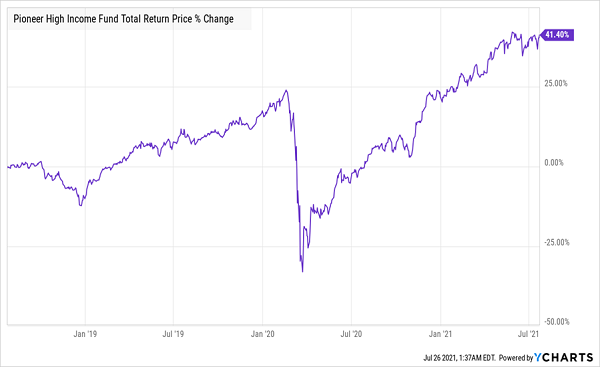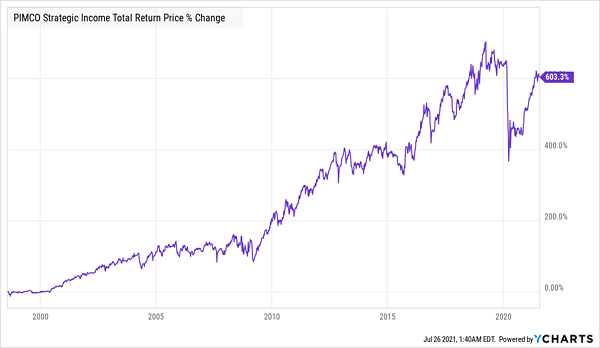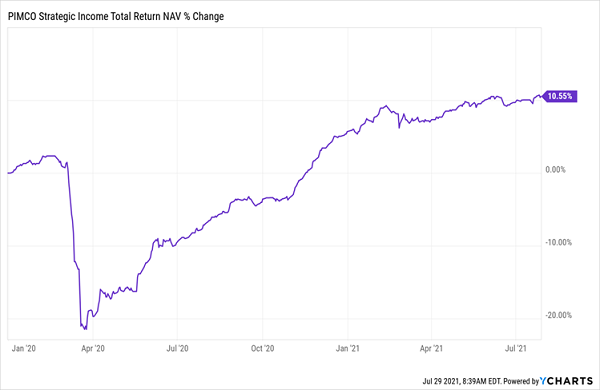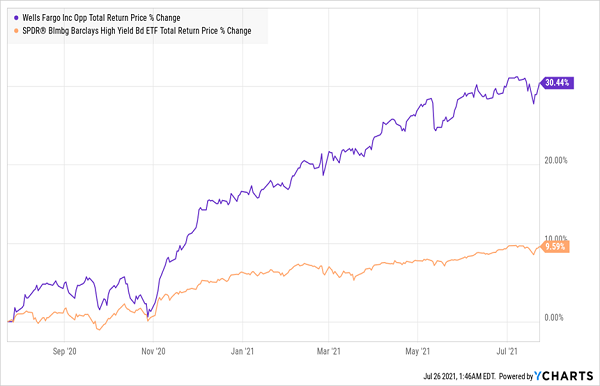Let’s shrug off today’s “dividend desert” and do something most folks think is impossible—ridiculous, even. We’re going to replace our monthly salary with a huge income stream from a group of closed-end funds (CEFs) that yield 7% or more (sometimes a lot more!).
The math here is simple: at a 7% dividend, you’ll have just shy of $3,000 ($2,917, to be precise) flowing into your account every month on a $500K investment. And yes, these dividends do flow your way monthly, right in line with your bills.
These CEFs have been paying these dividends for years, in some cases decades. And there are plenty of them, too: my CEF Insider service tracks 117 CEFs yielding over 7% and paying out every month.
We can get even higher dividends by teasing out a select subset of these funds. So let’s zero in on three corporate-bond CEFs that pay you an average dividend (paid monthly) of 8.2%. Try getting that from the typical (1.3%-yielding) S&P 500 stock!
With that kind of yield, a $500K investment in these three funds would get us a cool $3,410 in monthly dividend income—a game changer if you’re in (or near) retirement.
High-Yield CEF #1: An 8.7% Payout From America’s Strongest Companies
Let’s start with the Pioneer High Income Closed Fund (NYSE:PHT), which yields 8.7% and, yes, pays out monthly. But what’s really impressive is how durable this CEF is.
PHT Weathers the Worst the Market Can Throw at It

With a 13% annualized return over the last three years, we can see that PHT quickly bounced back from the March 2020 market crash. That’s in large part thanks to a diversified portfolio of over 300 bonds from firms ranging from Liberty Mutual Insurance to Alliance Data Systems (NYSE:ADS) and T-Mobile (NASDAQ:TMUS)—in other words, large, broad-based companies that have been reliably paying their bills for years.
That’s important because PHT gets interest from these companies’ loans. And thanks to the economic rebound, the fund’s income stream is safer than it’s been in years, which is why this big yielder is more than worth your attention now.
High-Yield CEF #2: An 8.2% Payout From a Top CEF Manager
The PIMCO Strategic Income Fund (NYSE:RCS) is worth taking notice of because of who manages it: PIMCO, one of the world’s largest bond investors, with over $2 trillion in assets under management. The firm is so big that the US government asked it to help buy mortgage-backed securities during the 2008 subprime-market meltdown, a moment that was highly profitable for PIMCO’s funds, including RCS.
The Power of Top-Flight Management

RCS has been growing investors’ wealth for a generation, but COVID-19 hit it hard, which is why the fund’s market price–based return is still below its long-term trend line.
But this weaker market-price performance doesn’t make sense, since the fund has been able to recover the value of its portfolio (or its net asset value in CEF-speak) from the worst days of the crisis and begun to increase its returns again.
RCS’s Portfolio Is Breaking Out, Even if the Market Doesn’t See It

That means RCS will likely attract more buyers soon, especially when investors take note of its 8.1% dividend. That makes now a good time to give this CEF a closer look.
High-Yield CEF No. 3: An Under-the-Radar 7.7% Monthly Payer
Not many investors give the Wells Fargo Income Opportunities Fund (NYSE:EAD) much attention. That’s because Wells Fargo (NYSE:WFC) is mainly known as a Main Street bank, not a CEF manager. But the fund’s low-key nature is precisely what’s setting up our opportunity here.
EAD yields 7.7%, and it provides that high dividend by holding bonds that are mainly issued by medium-sized businesses that are seeing higher cash flows due to the reopening economy.
You can see that in EAD’s portfolio, which contains bonds issued by Delta Air Lines (NYSE:DAL) and American Airlines (NASDAQ:AAL). And with a significant holding of bonds from Dell and EMC Corporation (NYSE:EMC), the fund is also poised to see a pickup in cash as skyrocketing demand for semiconductors drives profits for tech firms.
Management’s bond picks have already helped power EAD to a return that’s tripled that of the high-yield bond benchmark SPDR Bloomberg Barclays High Yield Bond ETF (NYSE:JNK).
EAD Outruns the High-Yield Bond Market

A big reason for this performance is the massive amounts of resources and top-level talent Wells attracts and makes available to EAD. No automated ETF, and few other CEFs, can match that advantage.
Putting It All Together
As we discussed earlier, these three funds alone are enough to get you an 8.2%-yielding portfolio with capital-gains upside. And they’ll pay you monthly, too, nicely setting you up to collect that $3,410 per month from a $500K nest egg.
And these three are just the start. Many CEFs offer similar yields and diversification into real estate, stocks and other assets to get you a diversified and high-yielding portfolio.
Disclosure: Brett Owens and Michael Foster are contrarian income investors who look for undervalued stocks/funds across the U.S. markets. Click here to learn how to profit from their strategies in the latest report, "7 Great Dividend Growth Stocks for a Secure Retirement."
